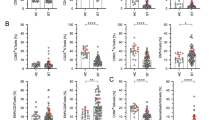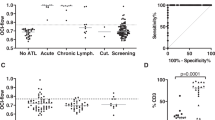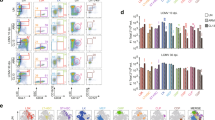Abstract
CD43 is a cell-surface sialoglycoprotein expressed by a variety of haematopoietically derived cells, including T lymphocytes1á¤-9. Earlier observations of defective CD43 expression by ? lymphocytes from boys with the X-chromosome-linked Wiskottá¤-Aldrich syndrome suggested the importance of CD43 in lymphocyte function10,11. Subsequent studies have suggested that CD43 facilitates leukocyte adhesion12á¤-14 and has a co-stimulatory role during T-cell activation15. To define the physiologically relevant function(s) of CD43, we have generated CD43-knockout mice. We report here that CD43-deficient T cells from such mice show a marked increase in their in vitro proliferative response to concana-valin A, anti-CD3, the superantigen SEB and allostimulation. Additionally, CD43-deficient ? cells show a substantial enhancement in homotypic adhesion and in their ability to bind different ligands, including fibronectin and the intercellular adhesion molecule ICAM-1. Vaccinia-virus-infected CD43-knockout mice mounted an augmented anti-vaccinia cytotoxic T-cell response compared with their wild-type littermates, yet developed an increased virus load. We conclude that CD43 negatively regulates T-cell activation and adhesion and is important for viral clearance.
This is a preview of subscription content, access via your institution
Access options
Subscribe to this journal
Receive 51 print issues and online access
$199.00 per year
only $3.90 per issue
Buy this article
- Purchase on SpringerLink
- Instant access to full article PDF
Prices may be subject to local taxes which are calculated during checkout
Similar content being viewed by others
References
Gahmberg, C. G., Hayry, P. & Andersson, L. C. J. Cell Biol. 68, 642–653 (1976).
Gahmberg, C. G. & Andersson, L. C. J. biol. Chem. 252, 5888–5894 (1977).
Brown, W. R. A., Barclay, A. N., Sunderland, C. A. & Williams, A. F. Nature 289, 456–460 (1981).
Remold-O'Donnell, E., Davis, A. E., Kenney, D., Bhaskar, K. R. & Rosen, F. S. J. biol. Chem. 261, 7526–7530 (1986).
Carlsson, S. R. & Fukuda, M. J. biol. Chem. 261, 12779–12786 (1986).
Remold-O'Donnell, E., Zimmerman, C., Kenney, D. & Rosen, F. S. Blood 70, 104–109 (1987).
Borche, L., Lozano, F., Vilella, R. & Vives, J. Eur. J. Immun. 17, 1623–1626 (1987).
Gunji, Y. et al. Blood 80, 429–436 (1992).
Moore, T., Huang, S., Terstappen, L. W. M. M., Bennett, M. & Kumar, V. J. Immun. 153, 4978–4987 (1994).
Parkman, R., Remold-O'Donnell, E., Kenney, D. M., Perrine, S. & Rosen, F. S. Lancet ii, 1387–1389 (1981).
Remold-O'Donnell, E. et al. J. exp. Med. 159, 1705–1715 (1984).
Axelsson, B., Youseffi-Etemad, R., Hammerstrom, S. & Perlmann, P. J. Immun. 141, 2912–2917 (1988).
Nong, Y. H., Remold-O'Donnell, E., LeBien, T. W. & Remold, H. G. J. exp. Med. 170, 259,–267 (1989).
Rosenstein, Y. et al. Nature 354, 233–235 (1991).
Park, J. K. et al. Nature 350, 706–709 (1991).
Gulley, M. L., Ogata, L. C., Thorson, J. A., Dailey, M. O. & Kemp, J. D. J. Immun. 140, 3751–3757 (1988).
Wiken, M., Bjorck, P., Axelsson, B. & Perlmann, P. Scand. J. Immun. 28, 457–464 (1988).
Bettaib, A. et al. Blood. 71, 1226–1233 (1988).
Hardy, R. R., Carmack, C. E., Shinton, S. A., Kemp, J. D. & Hayakawa, K. J. exp. Med. 173, 1213–1225 (1991).
Mentzer, S. J. et al. J. exp. Med. 165, 1382–1392 (1987).
Marlin, S. D. & Springer, T. S. Cell 51, 813–819 (1987).
deFougerelles, A. R., Qin, X. & Springer, T. A. J. exp. Med. 179, 619–629 (1994).
Ardman, B., Sikorski, M. A. & Staunton, D. E. Proc. natn. Acad. Sci. U.S.A. 89, 5001–5005 (1992).
Manjunath, N., Johnson, R. S., Staunton, D. E., Pasqualini, R. & Ardman, B. J. Immun. 151, 1528–1534 (1994).
Bierer, B. E., Sleckman, B. P., Ratnofsky, S. E. & Burakoff, S. J. A. Rev. Immun. 7, 579–599 (1989).
Dustin, M. L. & Springer, T. A. A. Rev. Immun. 9, 27–66 (1991).
Kuhlman, P., Moy, V. T., Lollo, B. A. & Brian, A. A. J. Immun. 146, 1773–1782 (1991).
Springer, T. Nature 346, 425–434 (1990).
Cyster, J. G., Shotton, D. M. & Williams, A. F. EMBO J. 4, 893–902 (1991).
Axelsson, B., Hammerstrom, S., Finne, J. & Perlmann, P. Eur. J. Immun. 15, 427–433 (1985).
Author information
Authors and Affiliations
Rights and permissions
About this article
Cite this article
Manjunath, ., Correa, M., Ardman, M. et al. Negative regulation of T-cell adhesion and activation by CD43. Nature 377, 535–539 (1995). https://doi.org/10.1038/377535a0
Received:
Accepted:
Issue date:
DOI: https://doi.org/10.1038/377535a0
This article is cited by
-
Targeting CD43 optimizes cancer immunotherapy through reinvigorating antitumor immune response in colorectal cancer
Cellular Oncology (2023)
-
Possible association of 16p11.2 copy number variation with altered lymphocyte and neutrophil counts
npj Genomic Medicine (2022)
-
Immunomodulatory effect of mesenchymal stem cells in chemical-induced liver injury: a high-dimensional analysis
Stem Cell Research & Therapy (2019)
-
CD43 sialoglycoprotein modulates cardiac inflammation and murine susceptibility to Trypanosoma cruzi infection
Scientific Reports (2019)
-
Genome-scale CRISPR activation screen uncovers tumor-intrinsic modulators of CD3 bispecific antibody efficacy
Scientific Reports (2019)



